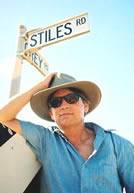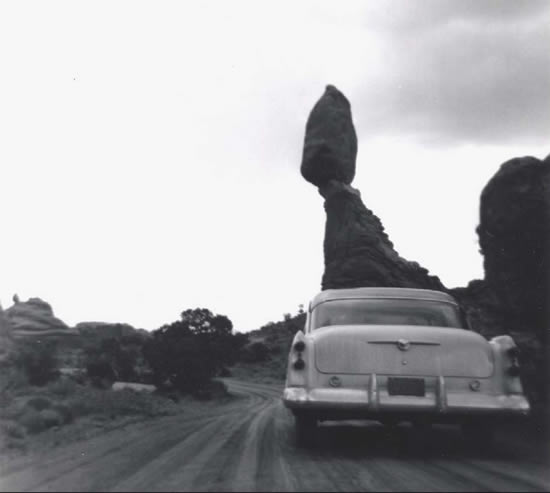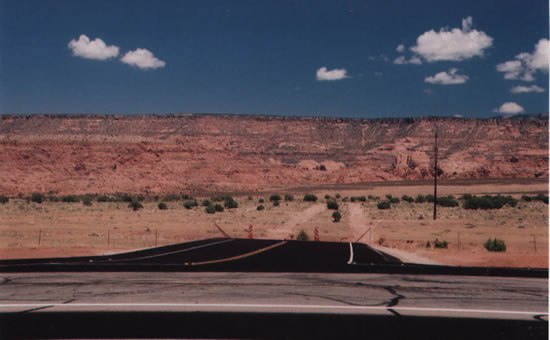

THE ROAD FROM CHATTANOOGA.
When I was about five years old, my family took our first real away-from-home vacation. We traveled from Louisville, Kentucky to Clearwater Beach, on the Gulf coast of Florida. The interstate freeway system was just beginning to take shape across America and most cities were in varying states of chaotic construction. Chattanooga, Tennessee was no different.
As my dad did his best to follow the detour signs and snake his way past flagmen and road graders, I stood happily on the floor of the back seat (in those glorious pre-seat belt days), with one hand on my dad's shoulder and one on my mom's, watching the new world pass in front of me.
Ahead of us, through the dust, I saw a dim figure walking through the weeds, just off the road surface. Suddenly, the car directly in front swerved hard to the right, as if it were aiming at the man, then it veered left. The double-motion caused the car's rear end to fishtail dangerously, but the driver held on and with a toot of his horn and a gesture I didn't understand, he accelerated away from us in a brown cloud.
My dad slowed down and we saw an old black man, in tattered clothes, rise from the weeds and beer cans and construction debris to dust himself off. My dad looked at him sympathetically and the old man nodded wearily. We drove on.
"Why did the car try to hit that colored man?" I asked.
My father did his best to explain racism and bigotry and evil, in general, to a small child and I still recall being touched by that incident in a profound way. I must have, or I wouldn't be recounting it all these decades later. As I grew older I saw it happen again and again.
I lived through the 60s, and I remember watching Martin Luther King's "Dream" speech as a boy, and hearing news of his assassination, five years later, as a young man. I saw the inner cities of America disintegrate into chaos and fire during countless race riots.
But I also noted the changes that were happening to the country. Just months before his death in 1968, Robert Kennedy, himself a Quixotic candidate for president, believed amidst the turmoil that an African-American could someday be elected president.
"There is no question about it," the senator said, "In the next 40 years a Negro could hold the same office that my brother attained....Progress has been made and will continue. We will not accept the staus quo."
And 30 years ago. Driving through Selma, Alabama in the mid-70s, I noted an African-American funeral procession on a hot August afternoon. I wrote in my journal:
"It was interesting to watch traffic yield for the black funeral. White people who, a decade ago, would have no doubt refused to yield the road to Blacks, even in death, pulled off the pavement to let the hearse and procession pass by, even here in Selma. The white people don't look pleased about it, just resigned. Maybe someday, it won't matter one way or the other."
Finally, in November 2008, Americans proved convincingly, for most of us, that race "didn't matter, one way or the other," and fulfilling RFK's prophesy. For me, the racial component of Barack Obama's election comes more of a shock, after the fact. It was more than the idea that Obama's race was irrelevant during the campaign; I simply kept forgetting to remember what his race was. I think millions more were just like me. And I think that sentiment, more than a desire to overcome past prejudices, is what decided the election. Only now do I find myself in awe of the outcome.
Too bad Bobby Kennedy wasn't here for the celebration.
THE ROAD AHEAD
I still recall Obama's first interview on "Meet the Press." With intelligence and grace and good humor he endured the grueling hour long interview with the late Tim Russert (who I still grieve for, all these months later...wouldn't Russert have loved to watch this campaign). I was impressed, more than anything, with Obama's candor. Russert ultimately asked the obligatory question about future presidential aspirations, and instead of a dissembling spew of silly ambiguities, Obama made it clear he hoped to pursue the office. Russert, looking almost shocked by the directness of the Illinois senator's reply, asked cautiously, "You don't mean in 2008, do you?"
Obama replied, "Yes, I'm thinking about it."
Two years later, as Barack Obama faces the greatest challenges as president since Franklin Roosevelt, I hope the realities of the world don't affect his candor. Or his vision.
I worry that Obama's greatness, in the 21st Century, will be sorely put to the test by a world far different than the one FDR faced 75 years ago. The last honest president, Jimmie Carter, was reviled within his own party for his honesty. Had we heeded his warnings, the world would be a very different place. In 2008, the very future of this lovely green globe hangs in the balance. Obama may be our last hope.
He must have the courage to demand a sacrifice from all of us. He must be willing to remind us what it truly means to be Americans and to help us connect to the things in life that really matter. If you will indulge me one last time, let me repeat President Carter's words from an address to the nation in 1979. It was a speech about America's energy crisis but it was so much more than that. It was about the quality of our lives and how we chose to define it:
In a nation that was proud of hard work, strong families, close-knit communities, and our faith in God, too many of us now tend to worship self-indulgence and consumption. Human identity is no longer defined by what one does, but by what one owns. But we've discovered that owning things and consuming things does not satisfy our longing for meaning. We've learned that piling up material goods cannot fill the emptiness of lives which have no confidence or purpose.
Often you see paralysis and stagnation and drift. You don't like it, and neither do I. What can we do?
First of all, we must face the truth, and then we can change our course. We simply must have faith in each other, faith in our ability to govern ourselves, and faith in the future of this Nation. Restoring that faith and that confidence to America is now the most important task we face. It is atrue challenge of this generation of Americans.
We know the strength of America. We are strong. We can regain our unity. We can regain our confidence. We are the heirs of generations who survived threats much more powerful and awesome than those that challenge us now. Our fathers and mothers were strong men and women who shaped a new society during the Great Depression, who fought world wars, and who carved out a new charter of peace for the world.
Here's the rub. The world Carter warned us about, one in which, "too many of us...worship self-indulgence and consumption," is precisely what the world of 2008 requires to maintain the kind of ever-expanding economy that much of its population demands. How does Obama break the cycle of consumption? How does he persuade all of us that "what we own" is not a measure of who we are? To break that cycle will mean hard times for many of us, but only if we keep measuring happiness in dollar bills.
And for the first time in human history, our consumptive habits are on the verge of dooming our very existence and every living thing on earth. The clock is ticking on climate change. Shortly after the election, Al Gore called Obama's election "transformative," but warned that we must, "begin an emergency rescue of human civilization from the imminent and rapidly growing threat posed by the climate crisis...To those who are still tempted to dismiss the increasingly urgent alarms from scientists around the world, ignore the melting of the north polar ice cap and all of the other apocalyptic warnings from the planet itself, and who roll their eyes at the very mention of this existential threat to the future of the human species, please wake up. Our children and grandchildren need you to hear and recognize the truth of our situation, before it is too late."
I hope Obama has the courage. I know he has the intelligence, and like I said, he is indeed our last best hope.
* At press time, Obama announced plans to stop expanded oil and gas drilling on sensitive public lands in southeast Utah. At long last, it's one Bush/Cheney hand that won't get played. BUT to paraphrase Wendell Berry's admonition, it's more than production we need to worry about these days. Consumption is what drives production and we are all culpbable.
SITLA LOOKS AHEAD
Last summer, road work at the far south end of Spanish Valley, in San Juan County puzzled me for months. Two major intersections were under construction, about a mile apart, complete with turning lanes and fresh striping. But the new roads went nowhere; the pavement traveled exactly 50 yards east to the highway right-of-way fence and stopped. Other than a vague double dozer track on the other side of one of them, leading into the pinyon-juniper, I could see no plan to proceed further. Then it occurred to me—these were Utah State Institutional Trust Lands and I wondered what SITLA was up to now.
I'd heard some speculation that the two new road intersections might have something to do with the never ending rumor that Wal-Mart planned to build on San Juan County SITLA lands. They'd make excellent Wal-Mart entrances for north and south-bound traffic.
But Bryan Torgeson of SITLA dismissed the rumor. "I've gotten those same Walmart speculation questions. However, I want to once again clarify that there is still no Walmart coming to San Juan County that I'm aware of and those turn lanes were not put in to accommodate any proposed big box development."
He explained that WW Clyde leases a gravel pit in Spanish Valley and was hoping for a more direct route to their pit. San Juan County and the BLM also got involved in the project. A more direct route to Ken's Lake from US 191 would enhance fire response times.
Then, according to Torgeson, "San Juan County looked at the road networks further south and determined that in addition to the new Ken's Lake road that another route could help with their road issues. They desired another route in the southern part of Spanish Valley. This proposed southern route was identified to relieve the traffic onto Spanish Valley Drive coming from Pack Creek and the Loop Road."
Finally, Torgeson noted, "The above were the main reasons and events that led to the decisions of the roads and turn lanes. However, we will likely have future development needs in the area. They will likely take place in the medium to far term. Those future development needs have not yet been identified or proposed, but the roads could facilitate any future development needs of SITLA's as well."
Indeed, along much of US 191, from Moab to Blanding, many SITLA sections that are adjacent to the highway, with easy access, are being developed for their residential potential. From the Lion's Back project and Cloudrock on Johnson's-Up-On-Top, to the top of Blue Hill, to the Wilson Arch Resort, to Flat Iron Mesa, to the ridge just north of Hatch Wash, to the Needles intersection and the area near the old Home of Truth, even to State Route 95, south of Blanding, just a half mile from its intersection with US 191---ALL of these locations are under various degrees of development. On almost all of them, home construction to some extent is underway.
Torgeson confirmed that, "Those developments that you referenced were once Trust Land. As was a majority of the private land throughout the state."
Whether the SITLA lands in Spanish Valley are developed to their full potential depends on many factors but, according to Torgeson, "What I can say is that all of the SITLA properties located in the Spanish Valley Area are designated for future development." He noted that the current economic downturn could mean that full development is in the distant future.
Is there any opposition to this longterm plan to exurbanize the rural lands of Southeast Utah into a web of ranchettes?
The Utah Recreational Land Exchange Act of 2007, sponsored by Rep. Jim Matheson (D-UT) and Sen. Bob Bennett (R-UT) stalled in both houses of Congress this year and awaits action in 2009. The legislation "protects valuable conservation lands along the Colorado River corridor near Moab by exchanging them with lands that are more suitable for development and may be used to benefit Utah's school children."
The Southern Utah Wilderness Alliance notes that, "Throughout Utah, state parcels lie within or adjacent to areas proposed for wilderness in America's Red Rock Wilderness Act, threatening the long-term protection of those areas. This bill places those lands in federal ownership in exchange for more developable land elsewhere for the state, and additionally withdraws approximately 20,000 acres of wilderness quality public land from all forms of mineral entry."
But while the bill addresses and would protect specific lands adjacent to the Colorado River, the patchwork development of SITLA lands elsewhere goes essentially unchallenged by anyone. One thing is certain, SITLA's goal is to develop those lands to their fullest economic potential and as long as that development is not related to mineral development or cattle grazing, environmentalists have little interest in objecting.
In 2003, noted Moab conservationist Bill Love posted an email about overgrazing on those very state sections in upper Spanish Valley that are being discussed here. He wrote: "Range Net is running a contest for the most overgrazed allotment in the western United States. The SITLA land around Ken's Lake has been nominated."
But what's worse? I asked Bill: "I'm trying to get a feel for just where environmentalists stand on this grazing issue....If SITLA announced that it wanted to take that overgrazed allotment and build 500 affordable housing units on it---would that be an agreeable alternative for you?"
Bill replied, "Your question cannot be answered because you are assuming there are only two choices for public lands and those are a cow or a house. Your question ignores the many alternatives that can include recreation, wildlife, housing, gravel mining, and grazing in the Ken's Lake area. I cannot pick a house or a cow as the solution"
So...me being me, I pressed: "It's purely hypothetical Bill...if you had only those two choices which is the lesser of two evils. Choosing the lesser of two evils is hardly a strange concept. It is the foundation of American politics. Can't just ONCE...a Utah enviro give a straight answer? I can...if those were my only choices I'd leave it overgrazed."
I didn't hear from him again...the unanswered question lingered.
Three years later, in 2006, SITLA moved forward with plans to develop a state section just east of the city limits, the Lions Back Resort; I asked Bill Love what could be done to stop it. Love wrote, "I can't see any way to stop Lions Back. The area will have more than 50% open space and does not contain any sensitive lands, that I know of. My goal is to try to prevent the entire valley from being 4 units per acre or even higher."
If rural Utahns have any hope of stopping further development of remote SITLA sections, they need to act now, on lands not even under current consideration. Get out your maps. Look at the locations of ALL SITLA lands adjacent to paved roads in scenic area. That is your SITLA blueprint for the future.









